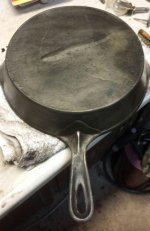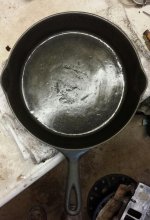This is my 1st time on any forum. Even though I'm a regular to this website. I am pretty much able to ID most CI I come across. I even ID for a local antique store. But I have a 7in skillet I can not ID. If you know what a series 2 erie looks like then you know what this pan looks like. Every single detail is the same except for it has a gate mark and it doesn't have anything else on it. This pan has been in my family for about 75 years that I know of. It hasn't been used in many years and I had never cleaned it, until this past weekend. It had quite a bit of build up on it. I was 100% sure I would have found 'Erie' under all that crud. And I would have never knew it had a gate mark. Build up was that bad. If anyone has any suggestions or ideas I will be glad to hear them. Thank you in advance.
-
If a web search for the answer to your cast iron cookware question has brought you directly to this forum, the information you seek may be covered in one of the many reference topics featured on the main website.
Quick Links: · Main Website · How to Identify Unmarked Pans · All About Cleaning & Seasoning · Reproductions & Counterfeits · Commonly-Used Terms
You are using an out of date browser. It may not display this or other websites correctly.
You should upgrade or use an alternative browser.
You should upgrade or use an alternative browser.
Need some help with a piece.
- Thread starter Shawn S
- Start date
Steve Stephens
Member
Careful Shawn, posting on forums can eat up more time than you can imagine.
And, all the while, being a lot of fun.
What you have is a skillet that is either of the same design as an ERIE or was copied from one, hence the bottom gate since it was probably copied over 100 years ago. Griswold did not bottom gate pieces other than about 3-5 early ones and no skillets. By the way, the numbers on old pans are size NUMBERS and not related to INCHES so your pan would be a "No. 7".
I have a No.9, bottom gated, no ghost ERIE markings but the pan's design is typical ERIE. Very light, more so than an ERIE and well cast. Sidney Hollow Ware, early Wagner, Marion, and a few other pans are spitting images of the early ERIE skillets but made so by reusing the old ERIE patterns or making quality patterns from the old ERIE pans. Could be that the same pattern maker even made patterns for more than one foundry.
And, all the while, being a lot of fun.
What you have is a skillet that is either of the same design as an ERIE or was copied from one, hence the bottom gate since it was probably copied over 100 years ago. Griswold did not bottom gate pieces other than about 3-5 early ones and no skillets. By the way, the numbers on old pans are size NUMBERS and not related to INCHES so your pan would be a "No. 7".
I have a No.9, bottom gated, no ghost ERIE markings but the pan's design is typical ERIE. Very light, more so than an ERIE and well cast. Sidney Hollow Ware, early Wagner, Marion, and a few other pans are spitting images of the early ERIE skillets but made so by reusing the old ERIE patterns or making quality patterns from the old ERIE pans. Could be that the same pattern maker even made patterns for more than one foundry.
Thank you for your reply. When I said 7in I actually was referring to the approx size of the pan. An 8in pan lid is to big And a 6in pan lid is to small. It isn't marked with a number anywhere. I know the number marking on older pans doesn't refer to pan size, but burner size for it to be used with.
I wasn't aware that the early Wagner and Sidney hollow ware used old Erie patterns. Thank you for the information. I just wanted to have an idea about what the pan may be since it's been in my family so long and I couldn't look at it and tell what is like I usually can. And thank you again.
I wasn't aware that the early Wagner and Sidney hollow ware used old Erie patterns. Thank you for the information. I just wanted to have an idea about what the pan may be since it's been in my family so long and I couldn't look at it and tell what is like I usually can. And thank you again.
Steve Stephens
Member
Even with a photo posted I don't know that anyone would be able to id your skillet. As for Wagner and Sidney Hollowware using Erie patterns that seems a good possibility if not a probability but still uncertain. All I know is that the pans are as close to matching as possible.
A little while before I posted this I had placed the pan back in a lye bath to finish getting a small amount of crud off. I removed it today. Here are pics of it. I didnt come here expecting to get a definitive answer on the manufacturer of it. Although that would be nice. I was just curious considering the design of it. I learned something new. I didnt know there was even a possibility that Erie allowed other manufacturers too use their old molds.
That is why I posted. I am always wanting to learn something about CI that I didnt know.
That is why I posted. I am always wanting to learn something about CI that I didnt know.
Attachments
Steve Stephens
Member
Your pan does look like it was copied from someone else's pan. MOLDS are not reusable as they are made of sand and have to be broken from around each piece. PATTERNS are the piece that is used repeatedly. I don't think Griswold would just allow others to use their old patterns but they may have sold the patterns or had some other agreement. This is all conjecture with no proof but how do all those ghost marks get into other makers' pieces? If a foundry were to copy a Griswold or other maker's pan there is nothing that could be done to stop them unless, maybe, the item being copied had a current patent on it. Your pan looks to have been made by an unidentifiable foundry.


